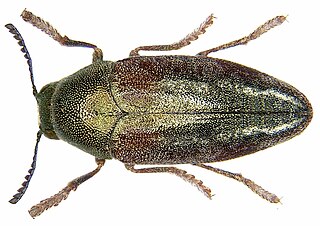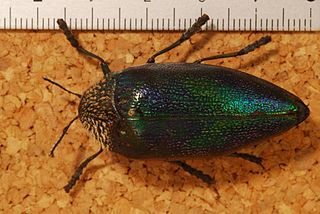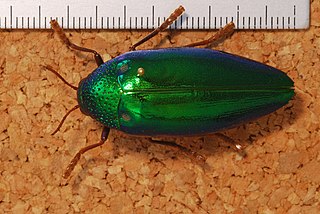
The family Scarabaeidae, as currently defined, consists of over 35,000 species of beetles worldwide; they are often called scarabs or scarab beetles. The classification of this family has undergone significant change in recent years. Several subfamilies have been elevated to family rank, and some reduced to lower ranks. The subfamilies listed in this article are in accordance with those in Catalog of Life (2023).

The glossy ibis is a water bird in the order Pelecaniformes and the ibis and spoonbill family Threskiornithidae. The scientific name derives from Ancient Greek plegados and Latin, falcis, both meaning "sickle" and referring to the distinctive shape of the bill.

The black-tailed godwit is a large, long-legged, long-billed shorebird first described by Carl Linnaeus in 1758. It is a member of the godwit genus, Limosa. There are four subspecies, all with orange head, neck and chest in breeding plumage and dull grey-brown winter coloration, and distinctive black and white wingbar at all times.

Buprestidae is a family of beetles known as jewel beetles or metallic wood-boring beetles because of their glossy iridescent colors. Larvae of this family are known as flatheaded borers. The family is among the largest of the beetles, with some 15,500 species known in 775 genera. In addition, almost 100 fossil species have been described.

Scutelleridae is a family of true bugs. They are commonly known as jewel bugs or metallic shield bugs due to their often brilliant coloration. They are also known as shield-backed bugs due to the enlargement of the thoracic scutellum into a continuous shield over the abdomen and wings. This latter characteristic distinguishes them from most other families within Heteroptera, and may lead to misidentification as a beetle rather than a bug. These insects feed on plant juices from a variety of different species, including some commercial crops. Closely related to stink bugs, they may also produce an offensive odour when disturbed. There are around 450 species worldwide.

Flower chafers are a group of scarab beetles comprising the subfamily Cetoniinae. Many species are diurnal and visit flowers for pollen and nectar, or to browse on the petals. Some species also feed on fruit. The group is also called fruit and flower chafers, flower beetles and flower scarabs. There are around 4,000 species, many of them still undescribed.

Beetlewing, or beetlewing art, is an ancient craft technique using iridescent beetle wings practiced traditionally in Thailand, Myanmar, India, China and Japan. Notable beetlewing garments include Lady Curzon's peacock dress (1903) and a costume dress worn by the actress Ellen Terry as Lady Macbeth, depicted in the painting Ellen Terry as Lady Macbeth (1889).

Sternocera is a genus of jewel beetles belonging to the Julodinae subfamily.

Julodis is a genus of beetles in the family Buprestidae.

Neojulodis is a genus of beetles in the family Buprestidae, containing the following species:

Julodis cirrosa, common name Brush Jewel Beetle, is a species of beetles belonging to the Buprestidae family. This species occurs in Southern Africa.

Sternocera aequisignata is a species of jewel beetles belonging to the subfamily Julodinae. Its bright metallic green elytra are frequently used in jewellery making.
Calloides is a genus of beetles in the family Cerambycidae, containing the following species:

Pteroplatus is a genus of beetles in the family Cerambycidae, containing the following species:

Sternocera pulchra is a beetle species found in Tanzania.

Trichostetha is a genus of beetle in the scarab beetle family. It is endemic to southern Africa, and its species most commonly occur in mountainous terrain. The genus includes several species that have only recently been described, as well as many species lacking a description of any of the larval stages. Except for T. fascicularis and its subspecies, the species comprising Trichostetha have small ranges of distribution, frequently in the Cape Floral Region of South Africa. The genus is believed to be related to Odontorrhina.

Julodis viridipes is a species of beetle belonging to the Buprestidae family.

Sternocera sternicornis is a species of beetles belonging to the Buprestidae family.

Sternocera ruficornis is a species of beetle belonging to the Buprestidae family. Its bright metallic green elytra are frequently used in jewellery making.
Eudicella frontalis is a beetle which belongs to the group of flower chafers in the superfamily Scarabaeoidea.

















